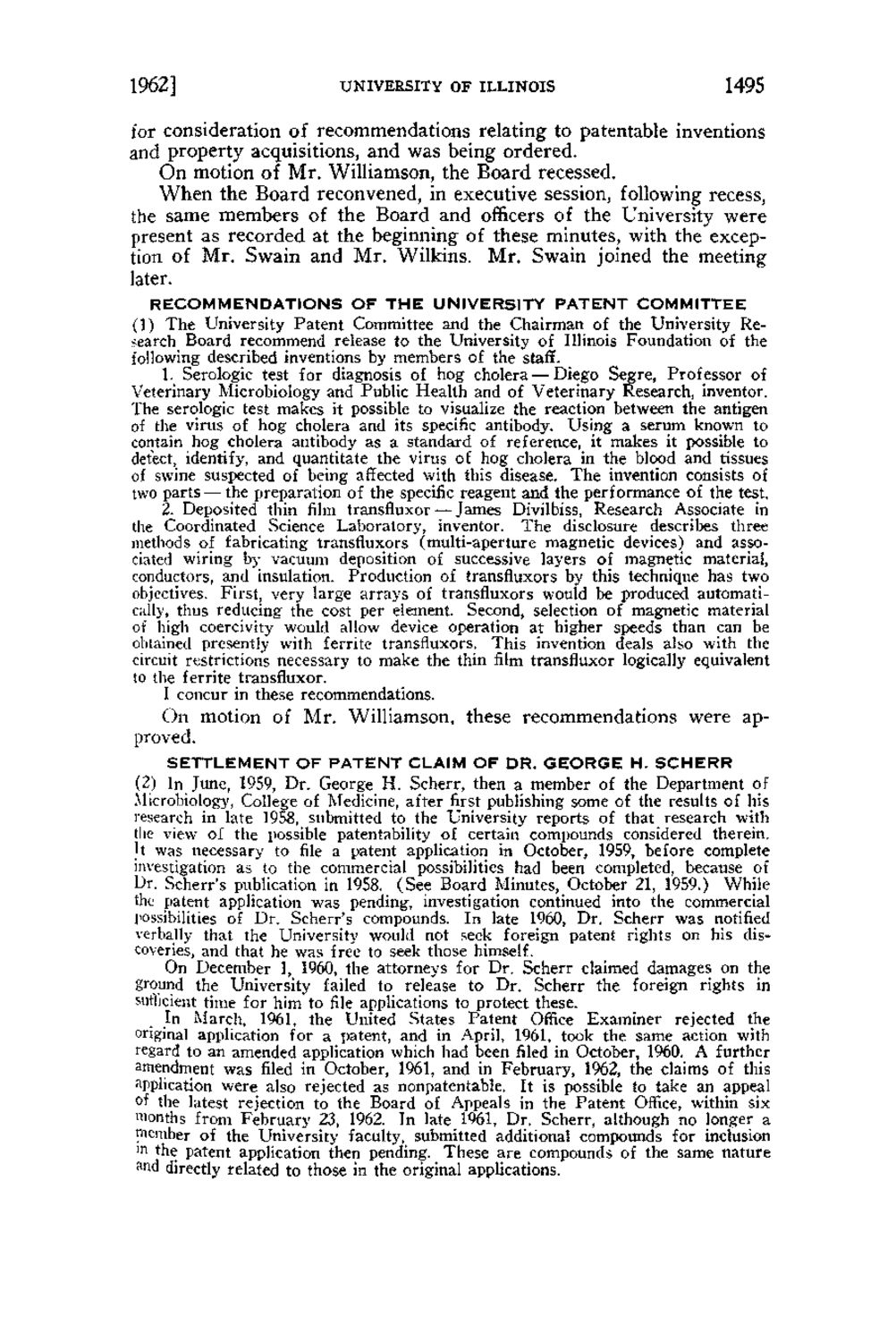| |
| |
Caption: Board of Trustees Minutes - 1962
This is a reduced-resolution page image for fast online browsing.

EXTRACTED TEXT FROM PAGE:
1962] UNIVERSITY OF ILLINOIS 1495 for consideration of recommendations relating to patentable inventions and property acquisitions, and was being ordered. On motion of Mr. Williamson, the Board recessed. When the Board reconvened, in executive session, following recess, the same members of the Board and officers of the University were present as recorded at the beginning of these minutes, with the exception of Mr. Swain and Mr. Wilkins. Mr. Swain joined the meeting later. RECOMMENDATIONS OF THE UNIVERSITY PATENT COMMITTEE (1) The University Patent Committee and the Chairman of the University Research Board recommend release to the University of Illinois Foundation of the following described inventions by members of the staff. 1. Serologic test for diagnosis of hog cholera—Diego Segre, Professor of Veterinary Microbiology and Public Health and of Veterinary Research, inventor. The serologic test makes it possible to visualize the reaction between the antigen of the virus of hog cholera and its specific antibody. Using a serum known to contain hog cholera antibody as a standard of reference, it makes it possible to detect, identify, and quantitate the virus of hog cholera in the blood and tissues of swine suspected of being affected with this disease. The invention consists of two parts — the preparation of the specific reagent and the performance of the test. 2. Deposited thin film transfluxor — James Divilbiss, Research Associate in the Coordinated Science Laboratory, inventor. The disclosure describes three methods of fabricating transfluxors (multi-aperture magnetic devices) and associated wiring by vacuum deposition of successive layers of magnetic material, conductors, and insulation. Production of transfluxors by this technique has two objectives. First, very large arrays of transfluxors would be produced automatically, thus reducing the cost per element. Second, selection of magnetic material of high coercivity would allow device operation at higher speeds than can be obtained presently with ferrite transfluxors. This invention deals also with the circuit restrictions necessary to make the thin film transfluxor logically equivalent to the ferrite transfluxor. I concur in these recommendations. On motion of Mr. Williamson, these recommendations were approved. SETTLEMENT OF PATENT CLAIM OF DR. GEORGE H. SCHERR (2) In June, 1959, Dr. George H. Scherr, then a member of the Department of Microbiology, College of Medicine, after first publishing some of the results of his research in late 1958, submitted to the University reports of that research with the view of the possible patentability of certain compounds considered therein. Jt was necessary to file a patent application in October, 1959, before complete investigation as to the commercial possibilities had been completed, because of Dr. Scherr's publication in 1958. (See Board Minutes, October 21, 1959.) While the patent application was pending, investigation continued into the commercial possibilities of Dr. Scherr's compounds. In late 1960, Dr. Scherr was notified verbally that the University would not seek foreign patent rights on his discoveries, and that he was free to seek those himself. On December 1, 1960, the attorneys for Dr. Scherr claimed damages on the ground the University failed to release to Dr. Scherr the foreign rights in sufficient time for him to file applications to protect these. In March, 1961, the United States Patent Office Examiner rejected the original application for a patent, and in April, 1961, took the same action with regard to an amended application which had been filed in October, 1960. A further amendment was filed in October, 1961, and in February, 1962, the claims of this application were also rejected as nonpatentable. It is possible to take an appeal °f the latest rejection to the Board of Appeals in the Patent Office, within six months from February 23, 1962. In late 1961, Dr. Scherr, although no longer a member of the University faculty, submitted additional compounds for inclusion 'n the patent application then pending. These are compounds of the same nature and directly related to those in the original applications.
| |